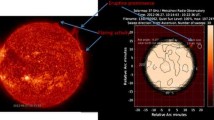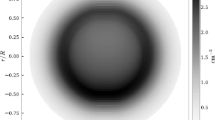Abstract
We studied the dynamical properties of a quiescent prominence using high-resolution observations provided by the Interface Region Imaging Spectroscopy (IRIS) and Atmospheric Imaging Assembly (AIA) onboard Solar Dynamics Observatory (SDO). The prominence is found to be shaped by two rotating magnetic structures. Both structures were formed after a EUV brightening followed by magnetic-flux emergence and cancelation. We computed the prominence’s Doppler velocities using the spectroscopic observations provided by IRIS. The temperature maps in the prominence regions are estimated using the Differential Emission Measure (DEM) of observations in the six Extreme Ultra-Violet (EUV) wavelengths obtained from SDO/AIA. The prominence has an average temperature of \(9.8\times 10^{4}\text{ K}\). The nonthermal velocity in the prominence was estimated to be between \(8\text{--}40\text{ km}\,\text{s}^{-1}\). We employed the Local Correlation Tracking (LCT) to find the plane-of-sky motions in the prominence. Thus, the measurements of plasma motions in two normal directions such as in the line-of-sight and in the plane-of-sky helped us to investigate the anticlockwise rotation of the prominence’s leg with a period of around 60 minutes when viewed from the top of it. We found dynamical motions of 20 to \(60\text{ km}\,\text{s}^{-1}\) in the prominence regions. On the other hand, one of the prominence’s legs was rotating in front of the other, first in the clockwise and after half an hour in the counterclockwise directions. We also found a sizable helical motion in the upper part of the prominence with a linear speed of \(6.71\text{ km}\,\text{s}^{-1}\). Further, the prominence was found to have significant oscillations in the frequency band 1.5–2.5 mHz, corresponding to a period range of 7–11 minutes.














Similar content being viewed by others
References
Arregui, I., Oliver, R., Ballester, J.L.: Prominence oscillations. Living Rev. Sol. Phys. 15(1) (2018). https://doi.org/10.1007/s41116-018-0012-6
Ballester, J.L.: Recent progress in prominence seismology. Philos. Trans. R. Soc. A 364(1839), 405–415 (2005). https://doi.org/10.1098/rsta.2005.1706
Berger, T.E., Shine, R.A., Slater, G.L., et al.: Hinode SOT observations of solar quiescent prominence dynamics. Astrophys. J. 676(1), L89–L92 (2008). https://doi.org/10.1086/587171
Chae, J., Ahn, K., Lim, E.K., et al.: Persistent horizontal flows and magnetic support of vertical threads in a quiescent prominence. Astrophys. J. 689(1), L73–L76 (2008). https://doi.org/10.1086/595785
Diaz, A.J., Oliver, R., Ballester, J.L.: Fast magnetohydrodynamic oscillations in cylindrical prominence fibrils. Astrophys. J. 580(1), 550–565 (2002). https://doi.org/10.1086/343039
Edwin, P., Roberts, B.: Wave propagation in a magnetic cylinder. Sol. Phys. 88(1–2) (1983). https://doi.org/10.1007/bf00196186
Engvold, O.: Observational aspects of prominence oscillations. Proc. Int. Astron. Union 3(S247), 152–157 (2007). https://doi.org/10.1017/s1743921308014816
Jing, J., Lee, J., Spirock, T.J., et al.: Periodic motion along solar filaments. Sol. Phys. 236(1), 97–109 (2006). https://doi.org/10.1007/s11207-006-0126-1
Karpen, J.T.: Plasma structure and dynamics. In: Solar Prominences, pp. 237–257. Springer, Berlin (2014)
Kucera, T.A., Ofman, L., Tarbell, T.D.: Motions in prominence barbs observed on the solar limb. Astrophys. J. 859(2), 121 (2018). https://doi.org/10.3847/1538-4357/aabe90
Labrosse, N., Heinzel, P., Vial, J.C., et al.: Physics of solar prominences: I—spectral diagnostics and non-LTE modelling. Space Sci. Rev. 151(4), 243–332 (2010). https://doi.org/10.1007/s11214-010-9630-6
Lemen, J.R., Title, A.M., Akin, D.J., et al.: The atmospheric imaging assembly (AIA) on the solar dynamics observatory (SDO). Sol. Phys. 275(1–2), 17–40 (2011). https://doi.org/10.1007/s11207-011-9776-8
Levens, P.J., Labrosse, N., Fletcher, L., et al.: A solar tornado observed by EIS. Astron. Astrophys. 582, A27 (2015). https://doi.org/10.1051/0004-6361/201425586
Levens, P.J., Schmieder, B., Ariste, A.L., et al.: Magnetic field in a typical prominence structures: bubble, tornado, and eruption. Astrophys. J. 826(2), 164 (2016a). https://doi.org/10.3847/0004-637x/826/2/164
Levens, P.J., Schmieder, B., Labrosse, N., et al.: Structure of prominence legs: plasma and magnetic field. Astrophys. J. 818(1), 31 (2016b). https://doi.org/10.3847/0004-637x/818/1/31
Li, X., Morgan, H., Leonard, D., et al.: A solar tornado observed by AIA/SDO: rotational flow and evolution of magnetic helicity in a prominence and cavity. Astrophys. J. 752(2), L22 (2012). https://doi.org/10.1088/2041-8205/752/2/l22
Lin, Y., Engvold, O., Wiik, J.E.: Counterstreaming in a large polar crown filament. Sol. Phys. 216(1/2), 109–120 (2003). https://doi.org/10.1023/a:1026150809598
Lin, Y., Engvold, O., van der Voort, L.H.M.R., et al.: Evidence of traveling waves in filament threads. Sol. Phys. 246(1), 65–72 (2007). https://doi.org/10.1007/s11207-007-0402-8
Lin, Y., Soler, R., Engvold, O., et al.: Swaying threads of a solar filament. Astrophys. J. 704(1), 870–876 (2009). https://doi.org/10.1088/0004-637x/704/1/870
Luna, M., Moreno-Insertis, F., Priest, E.: Are tornado-like magnetic strucures able to support solar prominence plasma? Astrophys. J. 808(1), L23 (2015). https://doi.org/10.1088/2041-8205/808/1/l23
Nakariakov, V.M., Ofman, L.: Determination of the coronal magnetic field by coronal loop oscillations. Astron. Astrophys. 372(3), L53–L56 (2001). https://doi.org/10.1051/0004-6361:20010607
Okada, S., Ichimoto, K., Machida, A., et al.: Temperature analysis of solar prominences by multi-wavelength observations. Publ. Astron. Soc. Jpn. 72(5) (2020). https://doi.org/10.1093/pasj/psaa014
Okamoto, T.J., Tsuneta, S., Berger, T.E., et al.: Coronal transverse magnetohydrodynamic waves in a solar prominence. Science 318(5856), 1577–1580 (2007). https://doi.org/10.1126/science.1145447
Okamoto, T.J., Antolin, P., Pontieu, B.D., et al.: Resonant absorption of transverse oscillations and associated heating in a solar prominence. I. Observational aspects. Astrophys. J. 809(1), 71 (2015). https://doi.org/10.1088/0004-637x/809/1/71
Okamoto, T.J., Liu, W., Tsuneta, S.: Helical motions of fine-structure prominence threads observed by hinode and iris. Astrophys. J. 831(2), 126 (2016). https://doi.org/10.3847/0004-637x/831/2/126
Oliver, R., Ballester, J.L.: Oscillations in quiescent solar prominences observations and theory – (invited review). Sol. Phys. 206(1), 45–67 (2002). https://doi.org/10.1023/a:1014915428440
Panesar, N.K., Innes, D.E., Tiwari, S.K., et al.: A solar tornado triggered by flares? Astron. Astrophys. 549, A105 (2013). https://doi.org/10.1051/0004-6361/201220503
Park, H., Chae, J., Song, D., et al.: Temperature of solar prominences obtained with the fast imaging solar spectrograph on the 1.6 m new solar telescope at the big bear solar observatory. Sol. Phys. 288(1), 105–116 (2013). https://doi.org/10.1007/s11207-013-0271-2
Pontieu, B.D., Title, A.M., Lemen, J.R., et al.: The interface region imaging spectrograph (IRIS). Sol. Phys. 289(7), 2733–2779 (2014). https://doi.org/10.1007/s11207-014-0485-y
Priest, E.R., Hood, A.W., Anzer, U.: A twisted flux-tube model for solar prominences. I - General properties. Astrophys. J. 344, 1010 (1989). https://doi.org/10.1086/167868
Schmieder, B., Kucera, T.A., Knizhnik, K., et al.: Propagating waves transverse to the magnetic field in a solar prominence. Astrophys. J. 777(2), 108 (2013). https://doi.org/10.1088/0004-637x/777/2/108
Schmieder, B., Tian, H., Kucera, T., et al.: Open questions on prominences from coordinated observations by IRIS, hinode, SDO/AIA, THEMIS, and the meudon/MSDP. Astron. Astrophys. 569, A85 (2014). https://doi.org/10.1051/0004-6361/201423922
Su, Y., Wang, T., Veronig, A., et al.: Solar magnetized “tornadoes:” relation to filaments. Astrophys. J. 756(2), L41 (2012). https://doi.org/10.1088/2041-8205/756/2/l41
Su, Y., Gömöry, P., Veronig, A., et al.: Solar magnetized tornadoes: rotational motion in a tornado-like prominence. Astrophys. J. 785(1), L2 (2014). https://doi.org/10.1088/2041-8205/785/1/L2. arXiv:1312.5226 [astro-ph.SR]
Terradas, J., Arregui, I., Oliver, R., et al.: Transverse oscillations of flowing prominence threads observed with hinode. Astrophys. J. 678(2), L153–L156 (2008). https://doi.org/10.1086/588728
Wang, Y.M.: On the relationship between He II \({\lambda}\)304 prominences and the photospheric magnetic field. Astrophys. J. 560(1), 456–465 (2001). https://doi.org/10.1086/322495
Weber, M., Deluca, E., Golub, L., et al.: Temperature diagnostics with multichannel imaging telescopes. Proc. Int. Astron. Union 2004(IAUS223), 321–328 (2004). https://doi.org/10.1017/s1743921304006088
Welsch, B.T., Fisher, G.H., Abbett, W.P., et al.: ILCT: recovering photospheric velocities from magnetograms by combining the induction equation with local correlation tracking. Astrophys. J. 610(2), 1148–1156 (2004). https://doi.org/10.1086/421767
Yang, Z., Tian, H., Peter, H., et al.: Two solar tornadoes observed with the interface region imaging spectrograph. Astrophys. J. 852(2), 79 (2018). https://doi.org/10.3847/1538-4357/aa9e04
Zirker, J.B., Engvold, O., Martin, S.F.: Counter-streaming gas flows in solar prominences as evidence for vertical magnetic fields. Nature 396(6710), 440–441 (1998). https://doi.org/10.1038/24798
Acknowledgements
IRIS is a NASA small explorer mission developed and operated by LMSAL with mission operations executed at NASA Ames Research Center and major contributions to downlink communications funded by ESA and the Norwegian Space Centre. AIA data are courtesy of NASA’s SDO and AIA science team. We thank the referee for his/her valuable comments and suggestions that helped us to improve the manuscript. One of the authors, RAM, acknowledges support from the NITC-FRG.
Author information
Authors and Affiliations
Contributions
Jain Jacob P.T. analysed the observational data and drafted the manuscript. Safna Banu K. reviewed the manuscript. R. A. Maurya guided the research work and edited the manuscript.
Corresponding author
Ethics declarations
Competing interests
The authors declare no competing interests.
Additional information
Publisher’s Note
Springer Nature remains neutral with regard to jurisdictional claims in published maps and institutional affiliations.
Supplementary Information
Below is the link to the electronic supplementary material.
Rights and permissions
Springer Nature or its licensor (e.g. a society or other partner) holds exclusive rights to this article under a publishing agreement with the author(s) or other rightsholder(s); author self-archiving of the accepted manuscript version of this article is solely governed by the terms of such publishing agreement and applicable law.
About this article
Cite this article
Jain Jacob, P.T., Ram Ajor, M. & Safna Banu, K. Dynamics of a quiescent prominence observed by IRIS and SDO/AIA. Astrophys Space Sci 368, 40 (2023). https://doi.org/10.1007/s10509-023-04195-1
Received:
Accepted:
Published:
DOI: https://doi.org/10.1007/s10509-023-04195-1




